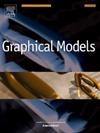CADTrans: A code tree-guided CAD generative transformer model with regularized discrete codebooks
IF 2.2
4区 计算机科学
Q2 COMPUTER SCIENCE, SOFTWARE ENGINEERING
引用次数: 0
Abstract
The creation of computational agents capable of generating computer-aided design (CAD) models that rival those produced by professional designers is a pressing challenge in the field of computational design. The key obstacle is the need to generate a large number of realistic and diverse models while maintaining control over the output to a certain degree. Therefore, we propose a novel CAD model generation network called CADTrans which is based on a code tree-guided transformer framework to autoregressively generate CAD construction sequences. Firstly, three regularized discrete codebooks are extracted through vector quantized adversarial learning, with each codebook respectively representing the features of Loop, Profile, and Solid. Secondly, these codebooks are used to normalize a CAD construction sequence into a structured code tree representation which is then used to train a standard transformer network to reconstruct the code tree. Finally, the code tree is used as global information to guide the sketch-and-extrude method to recover the corresponding geometric information, thereby reconstructing the complete CAD model. Extensive experiments demonstrate that CADTrans achieves state-of-the-art performance, generating higher-quality, more varied, and complex models. Meanwhile, it provides more possibilities for CAD applications through its flexible control method, enabling users to quickly experiment with different design schemes, inspiring diverse design ideas and the generation of a wide variety of models or even inspiring models, thereby improving design efficiency and promoting creativity. The code is available at https://effieguoxufei.github.io/CADtrans/.
CADTrans:代码树引导的 CAD 生成变换器模型与正则化离散代码本
创建能够生成与专业设计师制作的计算机辅助设计(CAD)模型相媲美的计算代理,是计算设计领域面临的一项紧迫挑战。关键的障碍是需要生成大量逼真、多样的模型,同时对输出结果保持一定程度的控制。因此,我们提出了一种名为 CADTrans 的新型 CAD 模型生成网络,该网络基于代码树引导的变换器框架,能够自回归地生成 CAD 建筑序列。首先,通过向量量化对抗学习提取三个正则化离散编码本,每个编码本分别代表环形、轮廓和实体特征。其次,利用这些编码本将 CAD 施工序列规范化为结构化的代码树表示法,然后用它来训练标准变换器网络以重建代码树。最后,将代码树作为全局信息,指导草图-挤出法恢复相应的几何信息,从而重建完整的 CAD 模型。大量实验证明,CADTrans 可生成更高质量、更多变化和更复杂的模型,其性能达到了最先进的水平。同时,它通过灵活的控制方法为 CAD 应用提供了更多可能性,使用户能够快速尝试不同的设计方案,激发多样化的设计思路,生成各种模型甚至是灵感模型,从而提高设计效率,促进创造力的发挥。代码可在 https://effieguoxufei.github.io/CADtrans/ 上获取。
本文章由计算机程序翻译,如有差异,请以英文原文为准。
求助全文
约1分钟内获得全文
求助全文
来源期刊

Graphical Models
工程技术-计算机:软件工程
CiteScore
3.60
自引率
5.90%
发文量
15
审稿时长
47 days
期刊介绍:
Graphical Models is recognized internationally as a highly rated, top tier journal and is focused on the creation, geometric processing, animation, and visualization of graphical models and on their applications in engineering, science, culture, and entertainment. GMOD provides its readers with thoroughly reviewed and carefully selected papers that disseminate exciting innovations, that teach rigorous theoretical foundations, that propose robust and efficient solutions, or that describe ambitious systems or applications in a variety of topics.
We invite papers in five categories: research (contributions of novel theoretical or practical approaches or solutions), survey (opinionated views of the state-of-the-art and challenges in a specific topic), system (the architecture and implementation details of an innovative architecture for a complete system that supports model/animation design, acquisition, analysis, visualization?), application (description of a novel application of know techniques and evaluation of its impact), or lecture (an elegant and inspiring perspective on previously published results that clarifies them and teaches them in a new way).
GMOD offers its authors an accelerated review, feedback from experts in the field, immediate online publication of accepted papers, no restriction on color and length (when justified by the content) in the online version, and a broad promotion of published papers. A prestigious group of editors selected from among the premier international researchers in their fields oversees the review process.
 求助内容:
求助内容: 应助结果提醒方式:
应助结果提醒方式:


